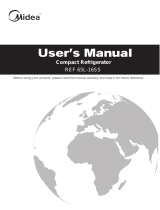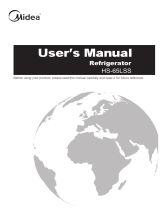Page is loading ...

INSTRUCTION MANUAL
REFRIGERATOR (FRIGO-BAR)
NV-1896
DEAR CUSTOMER
In order to achieve the best performance of your product, please read this instruction manual carefully
before using, and keep it for future reference.
If you need extra support, please write to [email protected]

P-1
CAUTION
RISK OF ELECTRIC
SHOCK, DO NOT
OPEN
Caution: To reduce the risk of electric shock do not open
this device, there are not serviceable parts for customers.
Please refer any maintenance or repair to qualified
personnel.
This sign means the existence of dangerous voltage at
the inside of the unit, which states a risk of electric shock.
This sign means that there are important instructions of
operation and handling in the manual that comes with this
device.
PREMIER CUSTOMER SERVICE
Venezuela:
0800 – ELECTRIC (353-2874)
Panama:
300-5185
Website
www.premiermundo.com
E-mail:
NOTE
This unit may be submitted to changes in specifications, characteristics and/or operation without prior
notice to the user, in order to continue improving and developing its technology.

P-2
GENERAL
This type of refrigerator is widely used in places such as hotels ,offices, student dormitories and houses.
It is mostly suitable for refrigerating and preserving foods such as fruits and beverage. It enjoys the
advantages of small size, Lightweight, Low electric consumption and easy use.
CHIEF TECHNICAL DATA
Input Power
83 W
Type of Preventing From Electric Shock
I
Refrigerant
32 g
Total Storage Volume
50 L
Rated Voltage
115 V
Rated Frequency
60 Hz
Climatic Class
ST
Instructions for Installation
1.Do not tilt the refrigerator for more than 45
0
form upright during moving it. And do not apply force on
any part such as condenser and door to prevent the refrigerator from deforming, or else it will
influence its performance.
2.Let the refrigerator have enough space to work well.
3.Don’t install it in high temperature of humidity place so as to avoid being damaged, dampened and
rusted.
Cautions for Safety
1.Before the refrigerator is plugged in check in the electric voltage to be used fit is the same as the rated
voltage. The power plug should have its independent socket, adapter may cause the socket overheat.
2.Don’t store inflammable materials such as ether, benzine, LP gas and glue etc in the refrigerator.
3.Don’t splash water on the refrigerator, it may arouse malfunction or electric shock.
4.When gas leaks from its container. Don’t pull the plug out or in. it may arose sparks and fire calamities.
Instructions for Use
1.When operating the refrigerator for the first time, run it without loading any food until it autos tops at
the desired temperature. Usually it takes 2 or 3hours,then set the thermostatic dial at the setting
desired and put foods in the refrigerator.
2.The temperature of the refrigerator can be adjusted by turning the thermostatic dial. A medium setting
of the thermostatic dial is the most suitable for general operation. Set the thermostat at “6” position
only when ice cubes are made or frozen food are stored in the freezing compartment.
3.Defrost the freezing compartment whenever the layer of frost on the surface of the evaporator reaches
3 or 4 mm. When defrosting remove all food and ice cube tray and set the thermostat at “OFF”
position. Put the drip tray under the evaporator to collect melted water. After the frost has melted,
discard the melted water and dry up the interior of refrigerator. The refrigerator can then be restarted
by turning its thermostat to the desired setting.
4.Instruction for making and removing pieces of ice cube.
Fill water into the ice making case below the graduated line, put it into the freezing compartment, and
then set the thermostat at “6” position. It takes about 2 or 3 hours to make ice cubes. Pieces of ice
cube can be removed by twisting the ice making case. Don’t cut up and down, otherwise it may be

P-3
broken.
CAUTIONS FOR USE
1.The more foods tuff put in or the more and the longer for once the door is opened, the more it needs
electric consumption, which even leads malfunction.
2.Better not to place the objects which are too heavy ,pointed or corrosion on table board.
3.Re-plugging in the power plug at the interval of over ten minutes.
4.Don’t store bottled drink in the freezer, so as to prevent from being broken and damaging the
refrigerator.
5.Open the door as less as possible during power-cut.
6.When defrosting, never use any sharp or metallic objects to remove the frost on the surface of the
evaporator as it will damage the evaporator.
7.Don’t touch foods and containers in the freezing compartment with your wet hands so as to prevent
from being frostbitten.
MAINTENANCE
1.While cleaning the refrigerator. pull out the electric power plug, rub carefully with a piece of cloth
soaked with natural cleanser then wipe with clean water. The abrasive cleaning power, alkali
cleansers, chemical cloth, thinner, alcohol, acid petroleum product and hot water are not suitable for
cleaning the refrigerator, they may damage the painting cover and plastics.
2.The door gasket is dirty and fogged easily, so clean it frequently.
3.If the refrigerator is out of use for a long time, please pull out the plug, clean and dry the freezing
compartment then close the door tightly.
THE FOLLOWING CASES ARE NOT MALFUNCTION
1.A flowing water sound:
Flowing water sound will be heard under normal operation.
2.Outside condensation:
Outside condensation is normal in high humidity condition. You may just wipe it up yourself.
3.It takes some times for the temperature of the freezer and refrigerator compartments to become cold
after the refrigerator starts to operate: If the temperature of the two compartments is higher while the
refrigerator is operating, it takes some times for the temperature of the two compartments to become
cold. If the environmental temperature is higher, it takes a long time to make the compartments to
become cold.
4. The surface of the compressor becomes hot:
The surface of the compressor may become hot under normal operation. Don’t touch it with hands.

P-4
METHODS OF INSPECTING MALFUNCTION
If any case of malfunction happens, please inspect and dispel it according to the methods shown in
the following table.
CASE
INSPECTION
Not refrigerating
• Is there no electric current.
• Is the voltage normal or not.
• Has the socket fused.
• Has the plug been put in effectively.
Not efficient
• Is the thermostatic dial set to the correct position.
• Is there any suitable clearance surrounding the
refrigerator.
• Has the door been opened too frequently or too long.
• Is the refrigerator exposed to sunlight directly or placed
near some heating devices.
• Are there too much food inside.
• Or are too hot.
Food frozen in the refrigerator
Compartment
• Is the thermostatic dial set to the correct position.
• Have the foods stuff been put too crowded.
Noises
• Is the refrigerator installed firmly.
• Has the refrigerator been struck by some other objects.
Compressor Cannot stop
automatically
• Are the foods stored too much at one setting.
• Are the doors opened too frequently or too long.
CIRCUIT DIAGRAM
/

